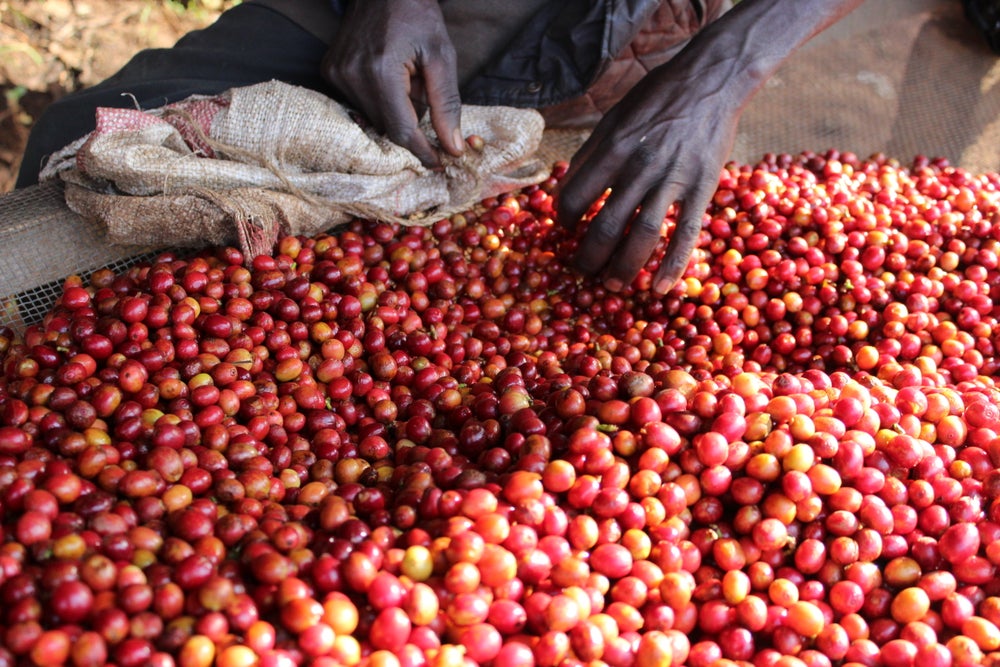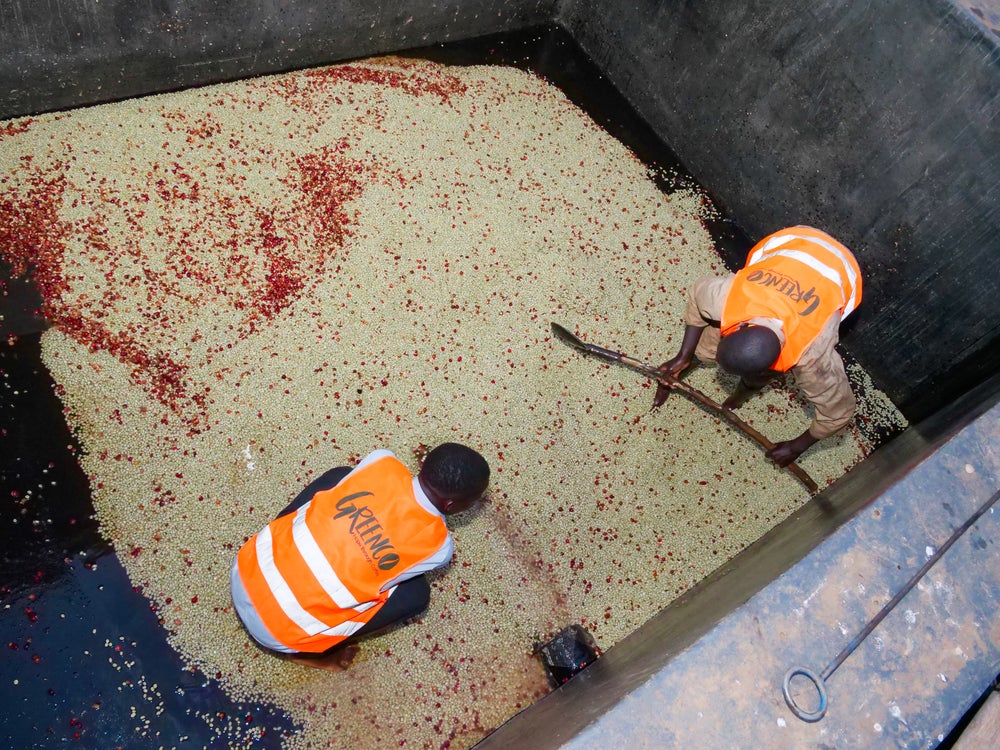About This Coffee
Every bag purchased contributes to a Farmgate Initiative project. Learn more.
Masha coffee washing station shares its name with the sub-hill upon which it stands. The sub-hill is actually more famous for its cattle than its coffee. The name Masha comes from the Kirundi word “amasho”, meaning “herds of cattle”. The sub-hill has been a crossroad for many herds in the region. Many of the local herders greet each other with a unique phrase only used in this region. They say, “gira amasho”, which means “owner of cows”.
Masha station was built in 1989. The majority farmers who deliver cherry are subsistence farmers. Farmers intercrop their trees with food crops and other cash crops to feed and support their families.
Cultivation
Many trees in Burundi are Red Bourbon. Because of the increasingly small size of coffee plantings, aging rootstock is a very big issue in Burundi. Many farmers have trees that are over 50 years old, but with small plots to farm, it is difficult to justify taking trees entirely out of production for the 3-4 years it will take new plantings to begin to yield. In order to encourage farmers to renovate their plantings, Greenco purchases seeds from the Institut des Sciences Agronomiques du Burundi (ISABU), establishes nurseries and sells the seedlings to farmers at or below cost. At the washing station, farmers can also get organic fertilizer derived from composted coffee pulp.
Despite the ubiquity of coffee growing in Burundi, each smallholder producers a relatively small harvest. The average smallholder has approximately 250 trees, normally in their backyards. Each tree yields an average of 1.5 kilos of cherry so the average producer sells about 200-300 kilos of cherry annually.
Harvest & Post-Harvest
During the harvest season, all coffee is selectively hand-picked. Most families only have 200 to 250 trees, and harvesting is done almost entirely by the family.
Quality assurance begins as soon as farmers deliver their cherry. Cherries are wet-processed under constant supervision. All cherry is floated in small buckets as a first step to check quality. Greenco still purchases floaters (damaged, underripe, etc) but immediately separates the two qualities and only markets floaters as B-quality cherry. After floating, the higher quality cherry is sorted again by hand to remove all damaged, underripe and overripe cherries.
After sorting, cherry is pulped within 6 hours of delivery. During pulping, cherry is separated into high- and low-grade by density on a Mackinon 3-disc pulper outfitted with an additional separation disk. Once pulped, coffee is placed in Epoxy-coated, concrete fermentation tanks. Oro yeast purchased from the French company Lalcafe is added to the tanks. The tanks are left to ferment in this environment for approximately 36 hours.
LALCAFÉ ORO™ yeast (Saccharomyces cerevisiae) was specially developed for coffee production over a four-year period of research and trials. Trials in various regions and environments showed that Oro is well suited to better control the wet process’ efficiency and to upgrade the cup quality. Oro’s ability to flourish even at low temperatures means it is equally suited for use across most altitudes. The yeast is able to control the fermentation process against the risk of spoilage micro-organisms that can generate undesirable defects. Furthermore, its specific metabolism and its high capacity even at cold temperatures (minimum 15°C inside the coffee tank) allows for the expression of fresh and fruity characteristics of the coffee beans while respecting the flavors of each unique coffee.
The longer fermentation time for yeast processed coffees (washed processed typically ferments for about 12 hours) also allows for more developed flavors. The extra time enables the beans to absorb metabolites, which can enhance flavors. Complexity, acidity, brightness, floral notes and more are all boosted by the lengthened fermentation time.
After fermentation is completed, coffee is run through washing and grading canals. In total, the channel separates beans into seven grades according to density. After washing, this parchment is poured onto wooden trays or into nylon bags and carried to the drying tables, each in its separate quality group. Each tray and nylon bag of parchment keeps its traceability tag with all info.
Parchment dries on raised beds for 2-3 weeks. During drying, parchment is repeatedly sorted and sifted to ensure even drying. Parchment is left to dry from sunrise to sunset and is covered with a sheet during the evening or when it rains.
Once dry, the parchment coffee is bagged and taken to the warehouse. Greenco’s team of expert cuppers assess every lot (which are separated by station, day and quality) at the lab. The traceability of the station, day and quality is maintained throughout the entire process.
Eddy Nkanagu, Managing Director at Greenco, a close Sucafina partner in Burundi, and Tim Heinze, Coffee Education Manager, discuss yeast fermentation methods in this video:
Quality Control at Greenco
Washing stations make the first payment to farmers between 15 and 30 June. The second payment comes later in the summer. If the coffee wins a competition or sells for extremely high specialty prices, Greenco gives another payment approximately a year after the harvest season.
Once dry, the parchment is bagged and taken to the warehouse. Greenco’s team of expert cuppers assess every lot (which remain separated by station, day and quality) at the lab. This level of traceability is maintained throughout the entire process.
Before shipment, coffee is sent to Budeca, Burundi’s largest dry mill. The coffee is milled and hand sorted by a team of hand-pickers who look closely at every single bean to ensure zero defects. It takes a team of two hand-pickers a full day to look over a single bag. UV lighting is also used on the beans and any bean that glows (which is usually an indication of a defect) is removed. The mill produces an average of 300 containers of 320 bags per year.
Budeca is located in Burundi’s new capital city, Gitega. The city has a population of around 30,000 people. Since there are approximately 3,000 people working at the mill, mostly as hand pickers, this means that Budeca employs nearly 10% of the total population in Gitega for at least half the year (during the milling season). The same is true in the provinces of Ngozi and Kayanza, where Greenco and Bugestal are the first employers in the region during the coffee harvest season. This has an incalculable impact on a country like Burundi, which has unemployment rates above 50%, especially in rural areas and among young people.
About Greenco
Greenco, a company that oversees and structures washing stations in Kayanza province of Burundi, gives washing stations and producers support all along the production chain. They started their work in 2015, and have dominated all Cup of Excellence competitions in Burundi ever since. Currently, Greenco has 13 washing stations all located in Kayanza in the north of Burundi. The producers receive support from the Greenco CWS managers, who are all agronomic engineers. Greenco’s overall impact through these 13 central washing stations (CWS) extends to over 15,210 coffee producing households.
Greenco works with young agronomy graduates to provide farmer training and manage washing stations. Young graduates are particularly well suited for the work with Greenco because they can all work with computer systems, greatly simplifying the flow of information between the washing stations and Greenco. Also, they have a fresh and systematic approach to coffee production and processing, with up-to-date knowledge about farming practices. The agronomists received additional training from the NGO Kahawatu Foundation on best agricultural practices (BAP). Off season, they provide agronomy assistance to the roughly 15,210 farmers who deliver cherries to Greenco CWS to prepare for the next harvest.
Another socio-economic challenge that Greenco addresses is youth unemployment. The national youth unemployment rate is almost 50%. At Greenco, young graduates receive a decent salary and benefits (house, motorbike, healthcare) as well as real career prospects.
Next to improving quality and productivity, Greenco strives to improve socio-economic and environmental conditions around the washing stations. All of their washing stations have UTZ and 4C certification. One of their focus points is building an efficient supply chain around the CWS. Greenco is buying 93% of its cherries directly from farmers via collection centers. This way, they improve farm-gate price to the producers.
In addition to providing training on farming practices, Greenco organizes trainings for farmer groups about various social aspects. Coffee families learn about gender equality, financial planning, family planning and more.
Environmental stewardship is of paramount importance to Greenco. They have equipped all washing stations with water treatment facilities and solar panels and batteries. The station has ponds to purify the wastewater from processing before flowing back in the river network. The solar panels provide energy for computers, lighting and smartphones.
Coffee in Burundi
Burundi has long been overlooked in comparison to its neighboring East African specialty coffee producing powerhouses. However, Burundi season, for us, is one of the highlights of the annual coffee calendar. The country’s coffee is produced almost entirely by smallholder farmers, and much of this small-scale production is of exceptional quality. With its super sweet, clean and often floral coffees, Burundi, every year, is increasingly is putting itself on the specialty coffee map.
Coffee is of paramount importance to families and the country at large. Considering this, improving and expanding coffee infrastructure is not just a way to improve incomes, it is a way to revolutionize the earning potential of an entire nation.
Building washing stations and expanding agricultural extension work can be great ways to improve coffee quality. Washing stations are pivotal in improving cup profile standards and the global reputation of Burundian coffee.
Both state-owned and private actors drive Burundi’s coffee industry and play key roles as washing station management companies and exporters. State-owned companies are called Sogestals, short for “Sociétés de Gestions des Stations de Lavage” (Washing station management companies). Privately-owned companies can operate under a variety of different names.
Sucafina’s history in Burundi goes back to 2007 when Bucafe/Sucafina Burundi was established in Bujumbura. Through Bucafe, we work with several privately-owned washing station management companies and exporters. Our work bridges the entire supply chain, allowing us to be vertically integrated. Our supply chain is solid, reliable and transparent. Due to this, we are more efficient, able to supply better value and positioned to offer both producers and consumers of Burundian coffee a diversity of expertise.

